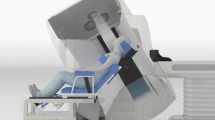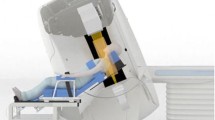Abstract
The present study examined the effect of bolus viscosity on the onset of laryngeal closure (relative to hyoid elevation), the duration of laryngeal closure, and other key events of swallowing in ten healthy volunteers. All volunteers underwent 320-row area detector computed tomography swallow studies while swallowing 10 ml of honey-thick barium (5 % v/w) and thin barium (5 % v/w) in a 45° reclining position. Three-dimensional images of both consistencies were created in 29 phases at an interval of 0.10 s (100 ms) over a 2.90-s duration. The timing of the motions of the hyoid bone, soft palate, and epiglottis; the opening and closing of the laryngeal vestibule, true vocal cords (TVC), and pharyngoesophageal segment; and the bolus movement were measured and compared between the two consistencies. The result showed differing patterns of bolus movement for thin and thick liquids. With thin liquids, the bolus reached the hypopharynx earlier and stayed in the hypopharynx longer than with thick liquids. Among events of laryngeal closure, only the timing of TVC closure differed significantly between the two consistencies. With thin liquids, TVC closure started earlier and lasted longer than with thick liquids. This TVC movement could reflect a response to the faster flow of thin liquids. The results suggest that bolus viscosity alters the temporal characteristics of swallowing, especially closure of the TVC.



Similar content being viewed by others
References
Logemann JA. Swallowing physiology and pathology. Otolaryngol Clin North Am. 1988;21:613–23.
Sasaki CT, Isaason G. Functional anatomy of the larynx. Otolaryngol Clin North Am. 1988;21:595–612.
Ardan GM, Kemp FH. The protection of the laryngeal airway during swallowing. Br J Radiol. 1952;25:406–16.
Ardan GM, Kemp FH. Closure and opening of the larynx during swallowing. Br J Radiol. 1956;29:205–8.
Ardran GM, Kemp FH. The mechanism of the larynx. II. The epiglottis and closure of the larynx. Br J Radiol. 1967;40:372–89.
Fujii N, Inamoto Y, Saitoh E, Baba M, Okada S, Yoshioka S, Nakai T, Ida Y, Katada K, Palmer JB. Evaluation of swallowing using 320-detector-row multislice CT. Part I. Single and multiphase volume scanning for three-dimensional morphological and kinematic analysis. Dysphagia. 2011;26:99–107.
Inamoto Y, Fujii N, Saitoh E, Baba M, Okada S, Katada K, Ozeki Y, Kanamori D, Palmer JB. Evaluation of swallowing using 320-detector-row multislice CT. Part II. Kinematic analysis of laryngeal closure during normal swallowing. Dysphagia. 2011;26:209–17.
Dantas RO, Kern MK, Massey BT, Dodds WJ, Kahrilas PJ, Brasseur JG, Cook IJ, Lang IM. Effect of swallowed bolus variables on oral and pharyngeal phases of swallowing. Am J Physiol. 1990;258:675–81.
Lazarus CL, Logemann JA, Rademaker AW, Kahrilas PJ, Pajak T, Lazar R, Halper A. Effects of bolus volume, viscosity, and repeated swallows in nonstroke subjects and stroke patients. Arch Phys Med Rehabil. 1993;74:1066–70.
Tsukada T, Taniguchi H, Ootaki S, Yamada Y, Inoue M. Effects of food texture and head posture on oropharyngeal swallowing. J Appl Physiol. 2009;106:1848–57.
Bisch EM, Logemann JA, Rademaker AW, Kahrilas PJ, Lazarus CL. Pharyngeal effects of bolus volume, viscosity, and temperature in patients with dysphagia resulting from neurologic impairment and in normal subjects. J Speech Hear Res. 1994;37:1041–59.
Ding R, Logemann JA, Larson CR, Rademaker AW. The effects of taste and consistency on swallow physiology in younger and older healthy individuals: a surface electromyographic study. J Speech Lang Hear Res. 2003;46:977–89.
Reimers-Neils L, Logemann J, Larson C. Viscosity effects on EMG activity in normal swallow. Dysphagia. 1994;9:101–6.
Hiss SG, Strauss M, Treole K, Stuart A, Boutilier S. Effects of age, gender, bolus volume, bolus viscosity, and gustation on swallowing apnea onset relative to lingual bolus propulsion onset in normal adults. J Speech Lang Hear Res. 2004;47:572–83.
Perlman AL, Ettema SL, Barkmeier J. Respiratory and acoustic signals associated with bolus passage during swallowing. Dysphagia. 2000;15:89–94.
Mendell DA, Logemann JA. Temporal sequence of swallow events during the oropharyngeal swallow. J Speech Lang Hear Res. 2007;50:1256–71.
Kurosu A, Logemann JA. Gender effects on airway closure in normal subjects. Dysphagia. 2010;25:284–90.
Clavé P, de Kraa M, Arreola V, Girvent M, Farré R, Palomera E, Serra-Prat M. The effect of bolus viscosity on swallowing function in neurogenic dysphagia. Aliment Pharmacol Ther. 2006;24:1385–94.
Kendall KA, McKenzie S, Leonard RJ, Gonçalves MI, Walker A. Timing of events in normal swallowing: a videofluoroscopic study. Dysphagia. 2000;15:74–83.
Curtis DJ, Cruess DF, Dachman AH, Maso E. Timing in the normal pharyngeal swallow. Prospective selection and evaluation of 16 normal asymptomatic patients. Invest Radiol. 1984;19:523–9.
Ren J, Shaker R, Zamir Z, Dodds WJ, Hogan WJ, Hoffmann RG. Effect of age and bolus variables on the coordination of the glottis and upper esophageal sphincter during swallowing. Am J Gastroenterol. 1993;88:665–9.
Butler SG, Stuart A, Castell D, Russell GB, Koch K, Kemp S. Effects of age, gender, bolus condition, viscosity, and volume on pharyngeal and upper esophageal sphincter pressure and temporal measurements during swallowing. J Speech Lange Hear Res. 2009;52:240–53.
Logemann JA. Evaluation and treatment of swallowing disorders. 2nd ed. Austin: Pro-Ed; 1998. p. 214–22.
Acknowledgments
The authors thank Mr. Ida, Ms. Kataoka, and Mr. Kobayashi, radiological technologists at Fujita Health University Hospital, for their invaluable assistance with the CT study. They also appreciate the valuable advice provided by Dr. Arthur J. Miller at the Department of Orofacial Sciences, School of Dentistry, University of California at San Francisco.
Conflict of interest
The authors have no conflicts of interest or financial ties to disclose.
Author information
Authors and Affiliations
Corresponding author
Rights and permissions
About this article
Cite this article
Inamoto, Y., Saitoh, E., Okada, S. et al. The Effect of Bolus Viscosity on Laryngeal Closure in Swallowing: Kinematic Analysis Using 320-Row Area Detector CT. Dysphagia 28, 33–42 (2013). https://doi.org/10.1007/s00455-012-9410-4
Received:
Accepted:
Published:
Issue Date:
DOI: https://doi.org/10.1007/s00455-012-9410-4




